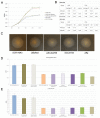Role and regulation of the Flp/Tad pilus in the virulence of Pectobacterium atrosepticum SCRI1043 and Pectobacterium wasabiae SCC3193
- PMID: 24040039
- PMCID: PMC3767616
- DOI: 10.1371/journal.pone.0073718
Role and regulation of the Flp/Tad pilus in the virulence of Pectobacterium atrosepticum SCRI1043 and Pectobacterium wasabiae SCC3193
Abstract
In this study, we characterized a putative Flp/Tad pilus-encoding gene cluster, and we examined its regulation at the transcriptional level and its role in the virulence of potato pathogenic enterobacteria of the genus Pectobacterium. The Flp/Tad pilus-encoding gene clusters in Pectobacterium atrosepticum, Pectobacterium wasabiae and Pectobacterium aroidearum were compared to previously characterized flp/tad gene clusters, including that of the well-studied Flp/Tad pilus model organism Aggregatibacter actinomycetemcomitans, in which this pilus is a major virulence determinant. Comparative analyses revealed substantial protein sequence similarity and open reading frame synteny between the previously characterized flp/tad gene clusters and the cluster in Pectobacterium, suggesting that the predicted flp/tad gene cluster in Pectobacterium encodes a Flp/Tad pilus-like structure. We detected genes for a novel two-component system adjacent to the flp/tad gene cluster in Pectobacterium, and mutant analysis demonstrated that this system has a positive effect on the transcription of selected Flp/Tad pilus biogenesis genes, suggesting that this response regulator regulate the flp/tad gene cluster. Mutagenesis of either the predicted regulator gene or selected Flp/Tad pilus biogenesis genes had a significant impact on the maceration ability of the bacterial strains in potato tubers, indicating that the Flp/Tad pilus-encoding gene cluster represents a novel virulence determinant in Pectobacterium. Soft-rot enterobacteria in the genera Pectobacterium and Dickeya are of great agricultural importance, and an investigation of the virulence of these pathogens could facilitate improvements in agricultural practices, thus benefiting farmers, the potato industry and consumers.
Conflict of interest statement
Figures





Similar articles
-
Revised phylogeny and novel horizontally acquired virulence determinants of the model soft rot phytopathogen Pectobacterium wasabiae SCC3193.PLoS Pathog. 2012;8(11):e1003013. doi: 10.1371/journal.ppat.1003013. Epub 2012 Nov 1. PLoS Pathog. 2012. PMID: 23133391 Free PMC article.
-
Genomic overview of the phytopathogen Pectobacterium wasabiae strain RNS 08.42.1A suggests horizontal acquisition of quorum-sensing genes.Genetica. 2015 Apr;143(2):241-52. doi: 10.1007/s10709-014-9793-2. Epub 2014 Oct 9. Genetica. 2015. PMID: 25297844
-
Genetic analysis of the requirement for flp-2, tadV, and rcpB in Actinobacillus actinomycetemcomitans biofilm formation.J Bacteriol. 2006 Sep;188(17):6361-75. doi: 10.1128/JB.00496-06. J Bacteriol. 2006. PMID: 16923904 Free PMC article.
-
Genes for tight adherence of Actinobacillus actinomycetemcomitans: from plaque to plague to pond scum.Trends Microbiol. 2001 Sep;9(9):429-37. doi: 10.1016/s0966-842x(01)02161-8. Trends Microbiol. 2001. PMID: 11553455 Review.
-
The Changing Face of Bacterial Soft-Rot Diseases.Annu Rev Phytopathol. 2018 Aug 25;56:269-288. doi: 10.1146/annurev-phyto-080417-045906. Epub 2018 Jun 29. Annu Rev Phytopathol. 2018. PMID: 29958075 Review.
Cited by
-
Type IV pilin regulation: a transcriptional overview.Crit Rev Microbiol. 2025 Jun 20:1-28. doi: 10.1080/1040841X.2025.2520778. Online ahead of print. Crit Rev Microbiol. 2025. PMID: 40539451 Review.
-
Tad pili contribute to the virulence and biofilm formation of virulent Aeromonas hydrophila.Front Cell Infect Microbiol. 2024 Jul 31;14:1425624. doi: 10.3389/fcimb.2024.1425624. eCollection 2024. Front Cell Infect Microbiol. 2024. PMID: 39145307 Free PMC article.
-
A stealth adhesion factor contributes to Vibrio vulnificus pathogenicity: Flp pili play roles in host invasion, survival in the blood stream and resistance to complement activation.PLoS Pathog. 2019 Aug 22;15(8):e1007767. doi: 10.1371/journal.ppat.1007767. eCollection 2019 Aug. PLoS Pathog. 2019. PMID: 31437245 Free PMC article.
-
Genome sequencing of two Neorhizobium galegae strains reveals a noeT gene responsible for the unusual acetylation of the nodulation factors.BMC Genomics. 2014 Jun 19;15(1):500. doi: 10.1186/1471-2164-15-500. BMC Genomics. 2014. PMID: 24948393 Free PMC article.
-
Genome-Wide Analyses Revealed Remarkable Heterogeneity in Pathogenicity Determinants, Antimicrobial Compounds, and CRISPR-Cas Systems of Complex Phytopathogenic Genus Pectobacterium.Pathogens. 2019 Nov 20;8(4):247. doi: 10.3390/pathogens8040247. Pathogens. 2019. PMID: 31756888 Free PMC article.
References
-
- Ma B, Hibbing ME, Kim H-S, Reedy RM, Yedidia I, et al. (2007) Host range and molecular phylogenies of the soft rot enterobacterial genera pectobacterium and dickeya. Phytopathology 97: 1150–1163 doi:10.1094/PHYTO-97-9-1150 - DOI - PubMed
-
- Pitman AR, Harrow SA, Visnovsky SB (2009) Genetic characterisation of Pectobacterium wasabiae causing soft rot disease of potato in New Zealand. Eur J Plant Pathol 126: 423–435 doi:10.1007/s10658-009-9551-y - DOI
-
- Czajkowski R, Pérombelon MCM, van Veen JA, van der Wolf JM (15:04:53) Control of blackleg and tuber soft rot of potato caused by Pectobacterium and Dickeya species: a review. Plant Pathol. Available: http://onlinelibrary.wiley.com/doi/10.1111/j.1365-3059.2011.02470.x/abst.... Accessed 11 October 2011. - DOI
-
- Toth IK, van der Wolf JM, Saddler G, Lojkowska E, Hélias V, et al. (2011) Dickeya species: an emerging problem for potato production in Europe. Plant Pathol 60: 385–399 doi:–10.1111/j.1365–3059.2011.02427.x - DOI
-
- Charkowski A, Blanco C, Condemine G, Expert D, Franza T, et al. (2012) The role of secretion systems and small molecules in soft-rot enterobacteriaceae pathogenicity. Annu Rev Phytopathol 50: 425–449 doi:10.1146/annurev-phyto-081211-173013 - DOI - PubMed
Publication types
MeSH terms
Substances
Associated data
- Actions
LinkOut - more resources
Full Text Sources
Other Literature Sources
Molecular Biology Databases

